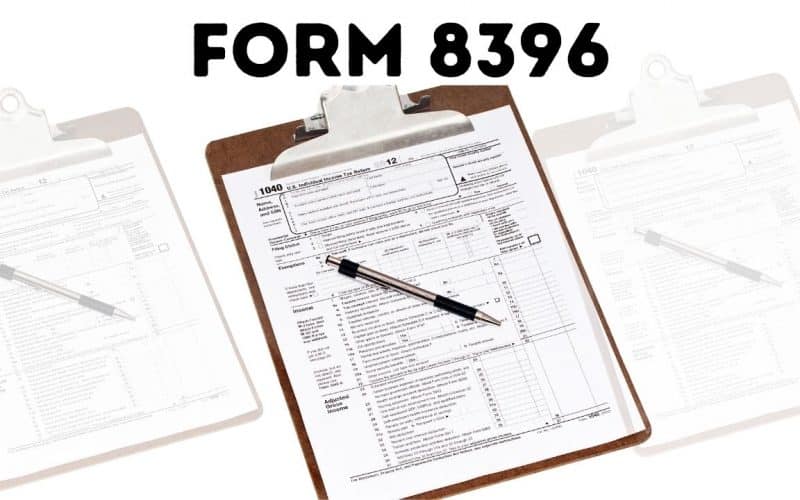Form 8396 is an Internal Revenue Service (IRS) form used by homeowners to claim mortgage interest credit. The aim of the mortgage interest credit is to help lower-income taxpayers afford homeownership. You can only claim the credit if you receive a mortgage credit certificate (MCC) from a state or local government agency. In this article, you will learn all that you need to know about Form 8396, including how to claim the mortgage interest deduction.
What is Mortgage Interest Credit?
Mortgage interest credit was created to help low and modest-income households. The intention is to reduce the income of eligible participants enough to qualify for home purchase incentive programs, including down payment assistance, from national housing finance agencies. and local.
A Mortgage Credit Certificate (MCC) is legally required to file a Form 8396 and claim the mortgage interest credit. The IRS form itself says, “You can only apply for the credit if you have received a qualified MCC by a state or local government unit or agency as part of a mortgage certificate program. qualified.
This means using a lender who participates in a local or national housing finance agency (HFA). The Federal Deposit Insurance Corporation (FDIC) said that 33 of the 54 HSAs listed in its latest guide to affordable mortgages offer the certificates. Income and other eligibility criteria vary. The National Council of State Housing Agencies is a good place to find the agency that serves your community.
What is the Purpose of Form 8396?
Form 8396 is the form that taxpayers can use to compute their mortgage interest credit for the year as well as any credit carryover to the following year. If you acquired a home this year and obtained a valid Mortgage Credit Certificate, you would utilize Form 8396 to report your mortgage interest credit to the IRS.
How to Prepare IRS Form 8396
Here is the step-by-step guide on how to prepare Form 8369:
- Enter Interest Paid
- Figure the Credit
- Adjust the Credit
- Carry the Credit Forward
#1. Enter the interest paid
You use the first part of Form 8396 to calculate the mortgage interest credit for the current year. Start by entering the interest you paid during the year on the mortgage specified by the MCC. Normally, you use the amount shown on the copy of Form 1098, Statement of Mortgage Interest, that you receive from your lender.
You will need to pro-rate interest if your mortgage exceeds the amount shown on the ACM. Do this by multiplying the total interest you paid by the ratio of the MCC loan amount to the original amount of your mortgage.
#2. Figure the Credit
Enter the credit rate shown on the MCC. If this rate is 20% or less, multiply it by the interest paid and enter the resulting pre-carry credit. If the MCC credit rate exceeds 20%, you must cap the tax credit before deferral at $ 2,000.
The new MCC must completely replace the previous one; the debt and credit ratio of the new MCC cannot exceed those of the previous one, and the pre-carry credit you calculate using the new MCC does not exceed the pre-carry credit you would have received on the previous MCC.
#3. Adjust the credit
Add the carried forward credits – mortgage interest credits that you have not used in the past three years – to the credit before carrying forward, which gives you the calculated credit. Next, determine the credit limit by completing the credit limit worksheet that accompanies the form. The spreadsheet allows you to determine your tax liability using information from other IRS forms.
#4. Carry the Credit Forward
Complete Part II only if your mortgage credit for the current year is less than your calculated credit, after adjusting for any credit limits. Through a series of steps, you eliminate any carry-overs from the previous three years and reallocate remaining and new carry-overs. Once completed, you will have carry-forward amounts for the current year and up to two previous years.
#5. Form 8396 instructions 2021
The filer of Form 8396 must include details, including their name, the name of the issuer of the MCC, the certificate number and issue date, and their Social Security Number on the form.
Line 1
Enter the interest you paid during the year on the loan amount
(certified indebtedness amount) shown on your MCC. In most
cases, this will be the amount in box 1 on Form 1098, Mortgage
Interest Statement, or on a similar statement you received from your
mortgage holder. If the loan amount on your MCC is less than your
total mortgage loan, you must allocate the interest to determine the
part that relates to the loan covered by the MCC. See Pub. 530 for
an example of how to allocate the interest.
Line 2
The certificate credit rate cannot be less than 10% or more than 50%.
Line 3
If you refinanced, see Refinanced Mortgage on this page.
If the certificate credit rate shown on line 2 is more than 20%,
multiply line 1 by line 2, but do not enter more than $2,000 on line 3.
If you and someone else (other than your spouse if filing jointly) held
an interest in the home, the $2,000 limit must be allocated to each
owner in proportion to the interest held.
Reduction of home mortgage interest deduction on Schedule A
(Form 1040). If you itemize your deductions on Schedule A, you must
reduce the amount of home mortgage interest you would otherwise
deduct on Schedule A by the amount on Form 8396, line 3, and
report the reduced amount on Schedule A.
Who Can File Form 8396: Mortgage Interest Credit?
Anyone who has obtained an MCC from a state or local government agency should complete this form. Typically, an MCC is only issued to low and moderate-income people as part of a new mortgage to purchase a primary residence. An MCC is issued as part of a qualified mortgage certificate program.
How to Claim the Mortgage Interest Deduction
You’ll need to take the following steps to claim your mortgage interest deduction :
#1. Look for Form 1098 in your mailbox:
Your mortgage lender sends you a Form 1098 in January or early February. It details how much you paid in mortgage interest and points during the tax year. Your lender sends a copy of this 1098 to the IRS, which will try to match it with what you report on your tax return. You will get 1098 if you paid the lender $ 600 or more in mortgage interest (including points) during the year. (Learn more about Form 1098 here.) You can also get year-to-date mortgage interest information from your lender’s monthly bank statements.
#2. Keep good records:
The good news is that you may be able to deduct mortgage interest in the situations below under certain circumstances:
- You used part of the house as a home office (you may need to complete a Schedule C and claim even more deductions). You owned an apartment in a cooperative.
- Have rented part of your house. The house was a timeshare. Part of the house was under construction during the year.
- You used some of the mortgage proceeds to pay off debt, invest in a business, or do something unrelated to buying a home.
- Your house was destroyed during the year.
- Divorced or separated and you or your ex have to pay the mortgage on a house you both own (the interest could actually be considered support).
- Someone who is not your spouse were responsible and paid mortgage interest on your house
#3. Itemize your taxes:
You claim the mortgage interest deduction on Schedule A of Form 1040, which means you will have to itemize instead of taking the standard deduction when you do your taxes. It can also mean spending more time preparing tax returns, but if your standard deduction is lower than your itemized deductions, you should still itemize and save money. If your standard deduction is greater than your itemized deductions (including your mortgage interest deduction), use the standard deduction and save time. (Learn more about the breakdown versus the standard deduction.) Schedule A allows you to do the math to calculate your deduction. Your tax software can guide you through the steps.
#4. See if you qualify for the special deduction rules:
If you have obtained assistance from a program of a state housing finance agency (“Hardest Hit Fund”) or an emergency homeowner loan program (the State or Department of Housing and Urban Development administers it), you may be able to deduct any payments you have made. on your mortgage during the year.
How Do I Know If I Qualify to File Form 8396?
According to the IRS, you can only claim the credit if you got an eligible mortgage credit certificate from a state or local government or agency in accordance with the provisions of a qualified mortgage credit certificate program.
Can Form 8396 be Filed Electronically?
Form 8396, along with your tax return, can be e-filed. However, if some component of your tax return prevents it from being e-filed, you must mail it to the IRS, including Form 8396.
Where Do I Mail Form 8396?
If you submit a paper return, you would mail Form 8396 together with your completed tax return to the address listed in your tax return instructions.
Conclusion
Mortgage Interest Credit is designed for people with low or modest incomes to help them access homeownership. Individuals eligible for the mortgage interest credit can apply for the credit each year for a portion of the mortgage interest paid.






